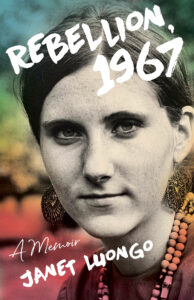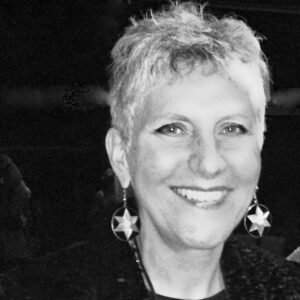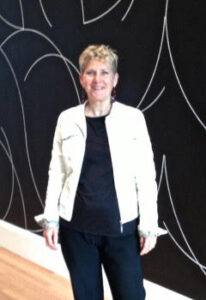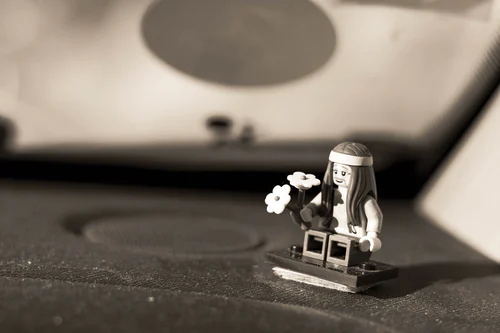
Today Book Club Babble is excited to be talking to Janet Luongo. Janet, thank you so much for joining us today. Let’s get started…
What inspired you to write your memoir? What is the story behind it?
The girl I was, who lived through a harrowing year in her adolescence, drove me to write her story. She was a bright student who studied hard for the prize of college, but found her dream ignored by parents absorbed in their own tumultuous relationship. She ventured out on her own at 17, living with her 16 year old sister in Queens, New York City. She found belonging and purpose working in the Black community for a mural painter, and for civil rights. She began the tuition-free City College in Manhattan, but the deadening daily three-hour commute led her to drop out to study art and work at a bookstore in Manhattan. She marched with Dr. Martin Luther King Jr. and met a Black jazz musician. After she protested excessive force by police, she had a blow-up with her father, an officer of the NYPD, and ran away with the musician. She experienced love and loss, heartbreak and danger, but found the strength to ask for help to pick up the pieces of her life and return to wholeness.
Who is Janet Luongo, the woman behind Rebellion, 1967?
I am a woman with heart who loves the literary and visual arts. I write and tell stories and give workshops and speeches; I teach and sometimes preach. I lead a group of voting rights activists. I work for progress on gender and racial justice. I am a life-long Unitarian Universalist; my faith encourages spiritual growth, a search for meaning and truth, inclusion, self-examination, kind deeds, service to humanity, and understanding that all existence is interrelated. Most summers I design a worship service. I am certified as a teacher of yoga and meditation. I am White, cisgender, wife, mother and grandmother with a lovely extended family and network of friends. I like hiking, photography, nutritious food, good films; I live with my affectionate husband and sweet cat in the diverse town of Norwalk on the Connecticut coast of the Long Island Sound where I am learning to kayak.
What was the most difficult part of writing your memoir?
It was difficult to delve deep into experiences in my life that were painful, disappointing, shattering; and difficult to pull on memory to relive the core emotions that motivated me to take so many risks in my young life. The arduous part came at the end of the process, the picky perfectionism needed in proofing the final manuscript.
How did you choose what to leave out and what to include?
It was difficult to choose what to cut because my style is to start with freewriting all random thoughts, emotions, and ideas as they pour out. Then I have to choose the best from the abundance of words. That’s when the critical part of the mind kicks in and one has to make an executive decision. Repetitive events were condensed. I left out duplication of ideas; I cut out any phrases, dialogue, and descriptions that did not move the story along, or were not necessary to give the reader a sense of time, place, and the main character’s motivation. I kept the scenes with high emotion; events that were singular or the first or last time something happened.
What is the biggest message you want to get across?
Dear Reader: Know and express who you truly are. Embrace every facet. Be compassionate to yourself and others. You are stronger than you may believe. Never give up on yourself.
Do you think that making meaning out of our stories is a form of therapy?
Viewing writing as a form of therapy rankled my first writing mentor, Patrick McCord. He considered writing an art and a craft, which I learned much about over four years in his writing group, “Write Yourself Free.” For me, writing the first draft of my memoir was definitely a form of therapy; in fact, I typed it out in a mental hospital. I’d kept notes in journals all through the harrowing experiences of 1967 that led to a breakdown and having the time to simply put down, in order, the events and emotions that led me to that point, was very healing. Self-discovery led to stronger drafts. Then the fun began: the art of shaping the story, and the craft of revision that allows the language to sing.
What has been your biggest learning experience since you started the process?
I have learned to be a really good editor. I can punch up verbs, re-order sentences for better flow, and cut away the excess with precision.
What is your goal? The big vision of what you want to achieve by putting your story out into the world?
My goal was to tell a good story, one that had pressed me for over fifty years to write drafts and to speak about to friends and audiences. My vision is that the issues I address – adolescent impulsivity, family relationships, substance abuse, racism, and justice – will be discussed. I told my story with honesty, showing both things I’m proud of and things I would not do again. All my characters, like myself, are mixed bags, both flawed and fabulous. I want readers to feel they can express themselves too, their whole selves. How can anyone who presents a false self ever feel truly loved? I write about how I found the strength to escape some daunting and dangerous challenges, and hope that readers, especially girls who have faced adversity, will find hope that they too can get back on a path to wholeness.
ABOUT THE AUTHOR
Janet Luongo writes stories, creates art, and gives speeches and workshops. Raised Unitarian Universalist in New York City, she holds an MSEd from Queens College at CUNY and taught art from kindergarten to college. While teaching at the International School of Geneva over several years, she exhibited paintings in Geneva and Paris. As an art education curator in Bridgeport museums, her innovative programs garnered grants, awards and media attention for connecting urban and suburban children and developing leadership in underserved teens. Her book, 365 Daily Affirmation for Creativity, with a foreword by Jack Canfield and published in five countries, led to presentations in the US and as far as Xian, China. To make diverse feminist artists visible, she founded a non-profit, which mounted forty exhibits. She co-produced the movie Women Make Art, which was screened at the UNIFEM film festival.
Her latest work, Rebellion, 1967, a memoir, was published by She Writes Press in July 2021. She resides with her husband, Jim, in Norwalk, Connecticut, and they enjoy hiking with their son and family in Colorado. More at www.janetluongo.com


